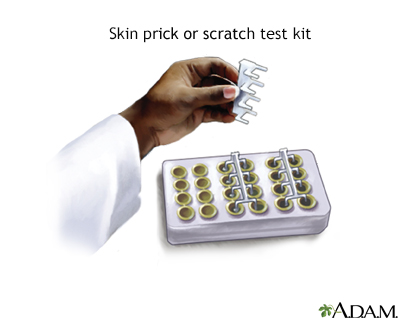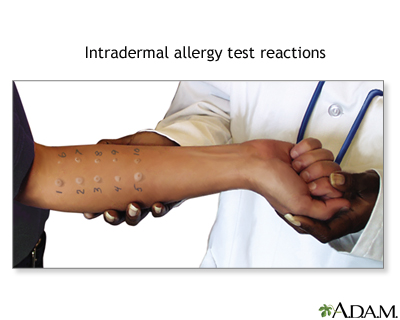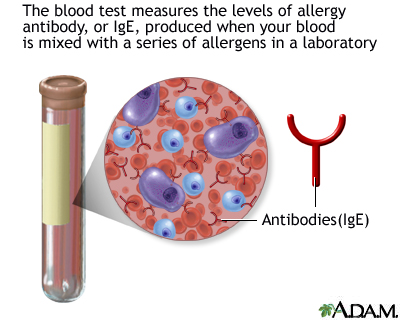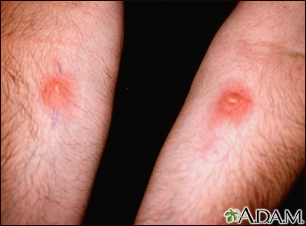Allergy testing - skin
Allergy skin tests are used to find out which substances cause a person to have an allergic reaction. These substances are called allergens.
Allergic reaction
An allergy is an immune response or reaction to substances that are usually not harmful.

Allergy testing - Animation
Every time you walk into your backyard, you start sneezing, sniffling, and feeling like you want to go back indoors. You're pretty sure you have an allergy, but what are you allergic to? Pollen? Grass? Your neighbor's Golden retriever? The only way to know for sure what's making you sneeze is to have allergy tests at your doctor's office. Let's talk about allergy testing. Your doctor may do one or more of several different types of allergy tests to see what's causing your allergies. One is a skin test. It can diagnose allergies to things like mold, pollen, animal fur, insect stings, and foods. With a skin test, your doctor will place a small amount of one substance, or several different substances just under the surface of the skin on your arm or back. You'll feel a little prick when the substances are placed under your skin. After 15 minutes or so, the doctor will look for signs that you're having a reaction. Usually your skin will get red or swollen if you're allergic to something in the test. Another way to test for allergies is to put a patch of the substance on your skin and leave it there for about 2 days, checking the area every day for any sign of a reaction. You may have a blood test. A blood test measures the amount of substances called antibodies that your body produces in response to a certain allergen. If you're allergic to food, you can try avoiding whatever foods you think might be making you sick. This is called elimination testing. Then you add back in each of the foods, one at a time, and look for signs of an allergic reaction. Your doctor may also try to trigger an allergic reaction in the office by having you eat the food or breathe in the substance you think causes your allergy. This is called a challenge test. The one risk to this test is that, if you're severely allergic, you could have a very serious reaction. Your doctor will watch you very closely during this test to make sure you're safe. Allergy tests are usually pretty accurate. But sometimes what bothers you in the real world won't show up on the test. If you have one test and it doesn't find your allergy trigger, your doctor may recommend having another type of test. Don't worry if it takes a while to find the source of your allergies. Your doctor will keep trying different methods until you learn exactly what's making you so miserable.
How the Test is Performed
There are three common methods of allergy skin testing.
The skin prick test involves:
- Placing a small amount of substances (allergens) that may be causing your symptoms on the skin, most often on the forearm, upper arm, or back.
Allergens
An allergen is a substance that can cause an allergic reaction. In some people, the immune system recognizes allergens as foreign or dangerous. As ...
 ImageRead Article Now Book Mark Article
ImageRead Article Now Book Mark Article - The skin is then pricked so the allergen goes under the skin's surface.
- The health care provider closely watches the skin for swelling and redness or other signs of a reaction. Results are usually seen within 15 to 20 minutes.
Swelling
Swelling is the enlargement of organs, skin, or other body parts. It is caused by a buildup of fluid in the tissues. The extra fluid can lead to a ...
 ImageRead Article Now Book Mark Article
ImageRead Article Now Book Mark Article - Several allergens can be tested at the same time.

Allergy skin prick or scratch test
One of the most common methods of allergy testing is the scratch test or skin prick test. The test involves placing a small amount of the suspected allergy-causing substance (allergen) on the skin (usually the forearm, upper arm, or the back), and then scratching or pricking the skin so that the allergen is introduced under the skin surface. The skin is observed closely for signs of a reaction, which usually includes swelling and redness of the site. With this test, several suspected allergens can be tested at the same time, and results are usually obtained within about 20 minutes.
The intradermal skin test involves:
- Injecting a small amount of allergen into the skin.
- The provider then watches for a reaction at the site.
- This test is more likely to be used to find out if you're allergic to bee venom or penicillin. Or it may be used if the skin prick test was negative and the provider still thinks that you're allergic to the allergen.

Intradermal allergy test reactions
Intradermal allergy testing is another method of skin testing to help determine whether an individual is allergic to a specific allergen. The test involves injection of a small amount of the suspected allergen under the surface of the skin. After about 20 minutes the area is examined for a reaction at the site. A typical reaction looks like a small hive with swelling and redness. The intradermal test is more sensitive than the skin prick test and can usually provide more consistent results.
Patch testing is a method to diagnose the cause of skin reactions that occur after the substance touches the skin:
- Possible allergens are taped to the skin for 48 hours.
- The provider will look at the area in 72 to 96 hours.
How to Prepare for the Test
Before any allergy testing, the provider will ask about:
- Illnesses
- Where you live and work
- Lifestyle
- Foods and eating habits
Allergy medicines can change the results of skin tests. Your provider will tell you which medicines to avoid and when to stop taking them before the test.
How the Test will Feel
Skin tests may cause very mild discomfort when the skin is pricked. Positive skin tests will become red, itchy and swollen like a bug bite.
You may have symptoms such as itching, a stuffy nose, red watery eyes, or a skin rash if you're allergic to the substance in the test.
In rare cases, people can have a whole-body allergic reaction (called anaphylaxis), which can be life threatening. This usually only occurs with intradermal testing. Your provider will be prepared to treat this serious response.
Anaphylaxis
Anaphylaxis is a life-threatening type of allergic reaction.

Patch tests may be irritating or itchy. These symptoms will go away when the patch tests are removed.
Why the Test is Performed
Allergy tests are done to find out which substances are causing your allergy symptoms.
Your provider may order allergy skin tests if you have:
- Hay fever (allergic rhinitis) and asthma symptoms that are not well controlled with medicine
Allergic rhinitis
Allergic rhinitis is a diagnosis associated with a group of symptoms affecting the nose. These symptoms occur when you breathe in something you are ...
 ImageRead Article Now Book Mark Article
ImageRead Article Now Book Mark Article - Hives and angioedema
Hives
Hives are raised, often itchy, red bumps (welts) on the surface of the skin. They can be an allergic reaction to food or medicine. They can also ap...
 ImageRead Article Now Book Mark Article
ImageRead Article Now Book Mark ArticleAngioedema
Angioedema is swelling that is similar to hives, but the swelling is under the skin instead of on the surface. Hives are often called welts. They a...
 ImageRead Article Now Book Mark Article
ImageRead Article Now Book Mark Article - Food allergies
Food allergies
A food allergy is a type of immune response triggered by eggs, peanuts, milk, shellfish or some other specific food.
 ImageRead Article Now Book Mark Article
ImageRead Article Now Book Mark Article - Skin rashes (dermatitis), in which the skin becomes red, sore, or swollen after contact with the substance
Dermatitis
Contact dermatitis is a condition in which the skin becomes red, sore, or inflamed after direct contact with a substance.
 ImageRead Article Now Book Mark Article
ImageRead Article Now Book Mark Article - Penicillin allergy
- Venom allergy
Allergies to penicillin and related medicines are the only medicine allergies that can be tested using skin tests.
The skin prick test may also be used to diagnose food allergies. Intradermal tests are not used to test for food allergies because of high false-positive results and the danger of causing a severe allergic reaction.
Normal Results
A negative test result means there were no skin changes in response to the allergen. This negative reaction most often means that you are not allergic to the substance.
In rare cases, a person may have a negative allergy test and still be allergic to the substance.
What Abnormal Results Mean
A positive result means you reacted to a substance. Your provider will see a red, raised area called a wheal.
Often, a positive result means the symptoms you're having are due to exposure to that substance. A stronger response means you are likely more sensitive to the substance.
People can have a positive response to a substance with allergy skin testing, but not have any problems with that substance in everyday life. Food allergy testing particularly carries a high risk of these false positive results.
Skin tests are usually accurate. But, if the dose of allergen is large, even people who are not allergic will have a positive reaction.
Your provider will consider your symptoms and the results of your skin test to suggest lifestyle changes you can make to avoid substances that may be causing your symptoms.
Reviewed By
Deborah Pedersen, MD, MS, Allergy & Asthma Care, PC, Taunton, MA. Review provided by VeriMed Healthcare Network. Also reviewed by David C. Dugdale, MD, Medical Director, Brenda Conaway, Editorial Director, and the A.D.A.M. Editorial team.
Chiriac AM, Bousquet J, Demoly P. In vivo methods for the study and diagnosis of allergy. In: Burks AW, Holgate ST, O'Hehir RE, et al, eds. Middleton's Allergy: Principles and Practice. 9th ed. Philadelphia, PA: Elsevier; 2020:chap 67.
Homburger HA, Hamilton RG. Allergic diseases. In: McPherson RA, Pincus MR, eds. Henry's Clinical Diagnosis and Management by Laboratory Methods. 24th ed. Philadelphia, PA: Elsevier; 2022:chap 56.
Nadeau KC. Approach to the patient with allergic or immunologic disease. In: Goldman L, Cooney KA, eds. Goldman-Cecil Medicine. 27th ed. Philadelphia, PA: Elsevier; 2024:chap 230.



 All rights reserved.
All rights reserved.